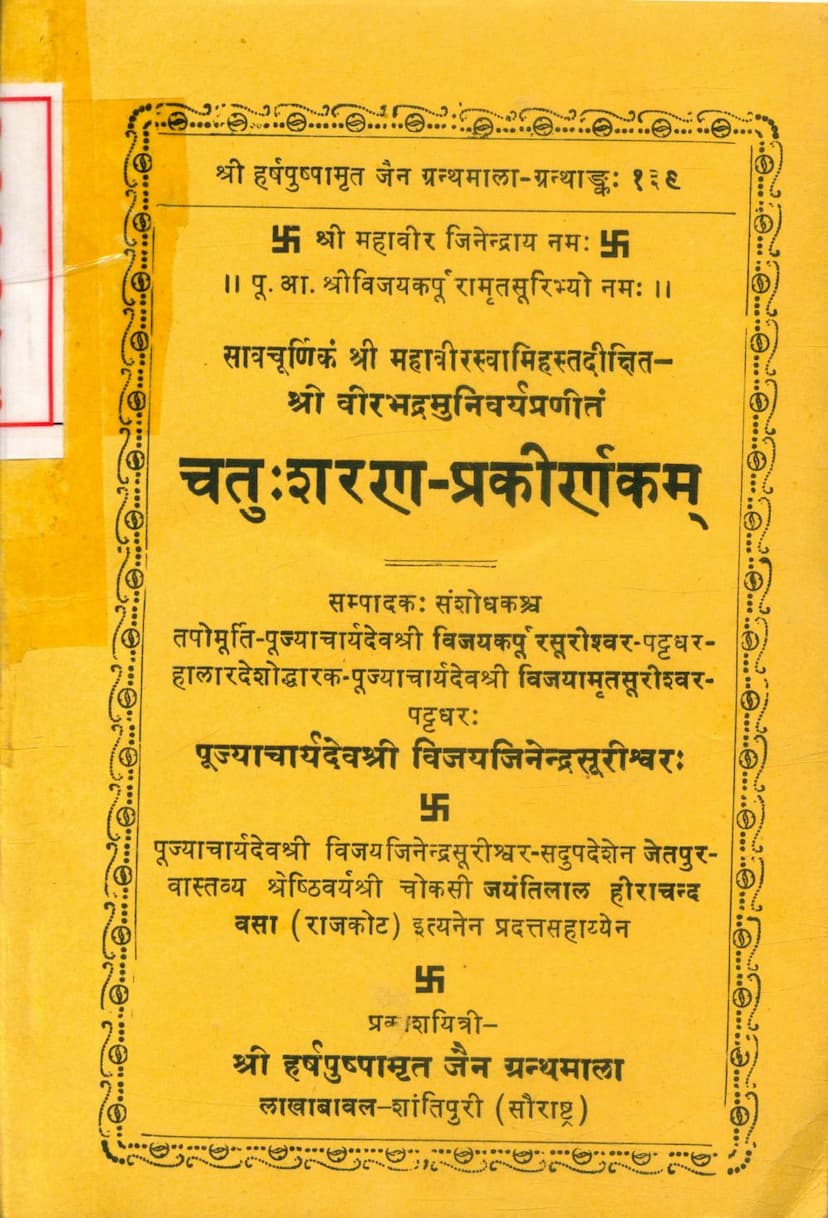Chatusharan Prakirnakam
Added to library: September 1, 2025

Summary
This is a comprehensive summary of the Jain text "Chatusharan Prakirnakam" based on the provided pages:
Book Title: Chatusharan Prakirnakam (चतुःशररण-प्रकीर्णकम्) Author: Muni Virabhadra (श्री वीरभद्रमुनिवर्य) Commentary (Avachurni): Anonymous Editor/Researched by: Acharya Vijay Jinendrasuri (पूज्याचार्यदेवश्री विजय जिनेन्द्रसूरीश्वरः) Publisher: Shri Harshpushpamrut Jain Granthmala (श्री हर्षपुष्पामृत जैन ग्रन्थमाला) Catalog Link: https://jainqq.org/explore/022604/1
Overall Purpose:
The "Chatusharan Prakirnakam" is a significant Jain scripture that outlines a path to spiritual liberation through the acceptance of four refuges or sources of solace. It is presented as a guide for spiritual practice, aiming to instill devotion and detachment, and ultimately lead to the cessation of suffering and attainment of moksha (liberation).
Key Themes and Structure:
The text is structured around the concept of Chatusharan (चतुःशरण), which translates to "Four Refuges." These four refuges are:
- Arhat (अरहंत): The first refuge is the veneration of Arhats, who are pure, omniscient beings who have conquered all passions and impurities. The text emphasizes their qualities such as being free from attachment and aversion, having attained omniscience, and being the bestowers of true happiness.
- Siddha (सिद्ध): The second refuge is the veneration of Siddhas, who are liberated souls residing in the Siddhashila. They are described as being free from birth, death, and all suffering, having attained eternal bliss and knowledge. The text highlights their pure and perfect nature.
- Sadhu (साधु): The third refuge is the veneration of Sadhus (monks), who follow the path laid out by the Arhats and Siddhas. They are characterized by their virtues like knowledge, conduct, penance, and detachment. The text details various types of Sadhus and their exemplary conduct.
- Dharma (धर्म): The fourth refuge is the acceptance of Dharma (the true Jain religion) as taught by the Tirthankaras. This includes adhering to the principles of non-violence, truthfulness, non-stealing, chastity, and non-possession, as well as practicing renunciation and meditation. The text emphasizes the auspiciousness and salvific power of this Dharma.
Content Breakdown and Key Sections:
- Mangala (Invocation): The text begins with a mangala (auspicious invocation) of Lord Mahavir, followed by homage to the Acharyas. It also highlights the purpose of the text, which is to bring about spiritual well-being and liberation.
- Six Essential Duties (Shad Avashyak): Before delving into the four refuges, the text outlines the six essential duties of a Jain practitioner, which are considered foundational for spiritual progress:
- Savadyayogavirati (सावद्ययोगविरति): Abstinence from sinful activities (mental, verbal, and physical).
- Utkirtana (उत्कीर्तन): Singing the praises of the Tirthankaras.
- Gunavata Pratipatti (गुणवन्तप्रतिपत्ति): Reverence and devotion towards virtuous beings (Gurus).
- Nindana (निन्दन): Repentance and condemnation of one's own faults or transgressions.
- Chikitsa (चिकित्सा): Remediation or curing of spiritual ailments.
- Dharana (धारणा): Upholding and practicing virtues and vows. The text explains how each of these essential duties contributes to the purification of conduct, perception, and knowledge.
- Detailed Explanation of the Four Refuges:
- Arhat Sharan (अरहच्छरण): The text dedicates a significant portion to describing the qualities of Arhats, such as their victory over attachment and aversion, their impeccable conduct, their divine knowledge, and their role in guiding humanity. It extols their ability to destroy karma and bestow peace.
- Siddha Sharan (सिद्धशरण): The description of Siddhas emphasizes their eternal existence in a state of pure bliss, free from all worldly limitations. Their transcendence over birth, death, and suffering is highlighted.
- Sadhu Sharan (साधुशरण): This section elaborates on the virtues and practices of Sadhus, including their knowledge of the scriptures, their adherence to vows, their asceticism, and their role as guides. It enumerates various categories of Sadhus based on their spiritual attainment and practices.
- Dharma Sharan (धर्मशरण): The text explains Dharma as the path of liberation, emphasizing its efficacy in eradicating karma and leading to happiness. It distinguishes the true Jain Dharma from other paths and stresses its role in attaining both worldly and spiritual well-being.
- Benefits of Following the Four Refuges: The text consistently highlights the immense benefits of adhering to these four refuges, including:
- Purification of karma.
- Attainment of auspicious results and liberation.
- Cessation of suffering and attachment.
- Development of virtues like compassion, contentment, and detachment.
- Overcoming obstacles and enemies (internal and external).
- Achieving the ultimate goal of moksha.
- Consequences of Neglecting the Refuges: The text also warns against the consequences of neglecting these spiritual principles, emphasizing the futility of human life without them and the potential for falling into lower states of existence.
- Conclusive Remarks: The text concludes by reiterating the importance of constantly meditating on and practicing these four refuges as a means to achieve the highest spiritual state. It emphasizes that this path, when followed with sincerity and devotion, leads to eternal happiness and liberation.
Methodology and Style:
The text employs a devotional and didactic style. It uses rich metaphors and allegories to illustrate the profound spiritual concepts. The commentary (Avachurni) provides detailed explanations of the verses, clarifying their meaning and significance. The inclusion of verses in Prakrit and the detailed explanations by the Acharyas suggest a scholarly and authoritative presentation of the teachings.
In essence, the "Chatusharan Prakirnakam" is a seminal Jain text that offers a practical and comprehensive framework for spiritual aspirants to attain liberation by taking refuge in the sacred beings (Arhats, Siddhas, Sadhus) and the eternal principles of Dharma. It is a call to cultivate devotion, practice self-discipline, and strive for spiritual purity to overcome the cycle of birth and death.